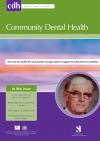Community Dental Health

- Cover Date:
- March 2012
- Print ISSN:
- 0265 539X
- Vol:
- 29
- Issue:
- 1
Number of teeth and its association with central obesity in older Southern Brazilians
doi:10.1922/CDH_2676Marchi05
Evidence suggests that older adults with extensive tooth loss may present dietetic restrictions and frequently choose softer and more processed foods, which consequently may lead to obesity. Objective: To evaluate whether there was an association between dental status and central obesity in community-dwelling elderly. Basic research design: A simple random sample of 471 community-dwelling Brazilian elderly ranging from 60 to 89 years old was evaluated in 2006. A questionnaire on socio-demographic, behaviour, general and oral health variables was applied. The number of natural teeth and the use of dental prostheses, following the World Health Organization (WHO) criteria, were assessed. Main outcome measures: The circumferences of the waist and the hip were measured in order to provide the waist circumference (WC) and the waist-hip ratio (WHR) measures. For both measures, participants were categorised as non-obese or obese according to the WHO-established cut-off points. Results: Participants with more than 8 teeth were less likely to have central obesity, as measured by WHR [OR=0.49 (0.32 to 0.87)], while participants with only 1-8 natural teeth were more likely to have central obesity when evaluated by WC [OR=3.28 (CI 1.43 to 7.52)]. Conclusions: Tooth loss was associated with central obesity, even when controlled for confounders, suggesting a relationship between oral health status and nutritional status in this sample of community-dwelling Brazilian elderly. Preserving natural teeth may have a positive impact on the nutritional status of older adults and on obesity-related morbidity.
Key words: tooth loss, obesity, waist-hip ratio, waist circumference, Brazil
- Article Price
- £15.00
- Institution Article Price
- £
- Page Start
- 85
- Page End
- 89
- Authors
- R.J. De Marchi, F.N. Hugo, J.B. Hilgert, D.M. Padilha
Articles from this issue
- Title
- Pg. Start
- Pg. End
- The caries experience of 11 to 12 year-old children in Scotland and Wales and 12 year-olds in England in 2008-2009: Reports of co-ordinated surveys using BASCD methodology
- 8
- 13
- Variations in caries diagnoses and treatment recommendations and their impacts on the costs of oral health care
- 25
- 28
- Associated factors of tooth wear among Malaysian 16-year-olds: a case-control study in Kota Bharu, Kelantan
- 33
- 38
- Factors associated with self-assessed masticatory ability among community-dwelling elderly Japanese
- 39
- 44
- Development and testing of a theory-based behavioural change intervention: A pilot investigation in a nursery school in a deprived area of Scotland
- 62
- 67
- Illness-related behaviour and sociodemographic determinants of oral health care use in Dabou, Côte d’Ivoire
- 78
- 84
- Perception of oral health related quality of life (OHQoL-UK) among periodontal risk patients before and after periodontal therapy
- 90
- 94
- Dental Fluorosis, Dental Caries, and Quality of Life Factors among Schoolchildren in a Colombian Fluorotic Area
- 95
- 99
- Relationship of Periodontal Disease to Pre-term Low Birth Weight Infants in a Selected Population - A Prospective Study.
- 100
- 105
- Orofacial pain symptoms and associated disability and psychosocial impact in community-dwelling and institutionalized elderly in Hong Kong
- 110
- 116
- Association of hyposalivation with oral function, nutrition and oral health in community-dwelling elderly Thai
- 117
- 123
- Assessment of the relationship between perceptions of dental aesthetics and demand for orthodontic treatment in 10 – 11 year old school children in Birmingham, UK.
- 124
- 128
